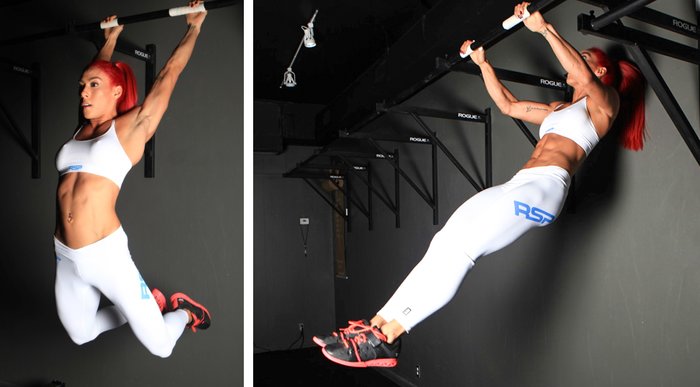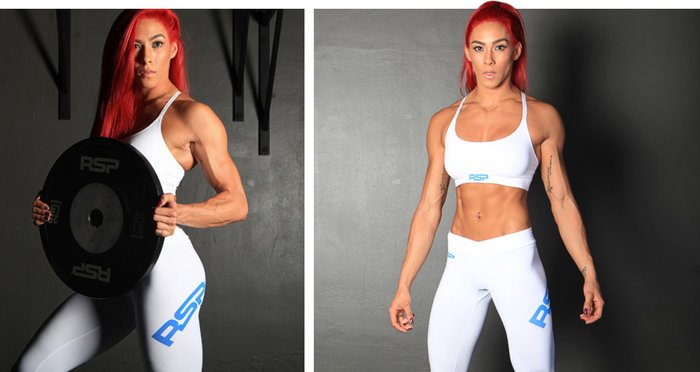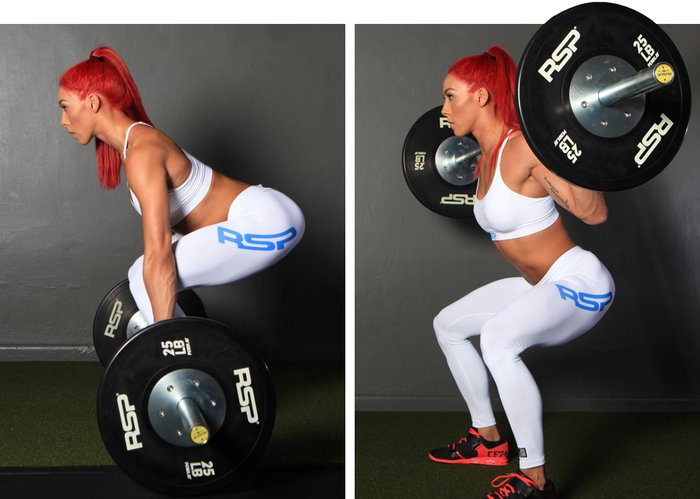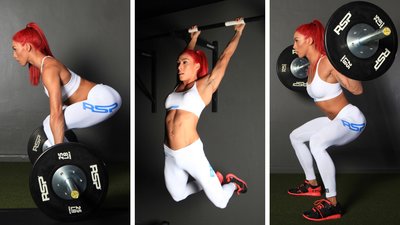All year long, you feel like you're improving. Your strength grows incrementally, and you can rock through mosttough WODs without wanting to croak. "Hey," you're thinking, "I can do this!"
And then along come the annual CrossFit Games Open workouts. The top-rated athletes soar through these challenges in videos that get hundreds of thousands of views, but for the slightly more casual CrossFit athlete, the Open standards often feel out of reach—and not by a little. So beginner athletes often end up scaling, skipping, or even worse, feeling ashamed.
If this sounds like a familiar problem, CrossFit athlete, coach, and RSP athlete Hannah Eden has your solution. These are what she identifies as the biggest hurdles keeping everyday CrossFitters from reaching those ambitious Open standards—and what you need to do to overcome them!
Problem 1: Ignoring What You're Bad At
"There is a term, 'cherry picking,' that refers to someone picking and choosing their workouts or movements," says Eden. "It's very common. Naturally, if we aren't good at something, we often avoid it. However, that's the worst thing you can do in this sport."
When Coach Eden sees cherry picking, she reminds her athletes that they didn't start out doing CrossFit. Instead, they came from a variety of backgrounds including weightlifting, gymnastics, powerlifting, bodybuilding, running—you name it. These other disciplines have left them strong in some areas, but relatively weak in others. Until they prioritize their weaknesses, they'll never be the well-balanced athlete that high-level CrossFit demands.
"Never avoid workouts that contain certain movements you cannot do," Eden adds. "Instead, scale down to a progression of that movement so that you can improve."

Don't cherry-pick your exercises. If you know your weaknesses, tackle them head-on.
Your Fix-It Strategy
If you know your weaknesses, write them down. Even better, spend some time with a qualified coach, and have them write your weaknesses down for you. That's step one.
Here's Step Two
"Take a deck of cards, and assign each suit to a movement or skill that is on your list of weaknesses," Eden advises. "At least a couple of times a week, shuffle the deck, randomly draw a card from each suit, and complete the number of reps on the card associated with that weakness."
Using a strategy like this, you will force yourself to focus on your lagging areas—whether you're working on specific skills, movements, or strength on a certain lift—and transcend those weaknesses over time.
Problem 2: Burnout
Another problem CrossFit athletes need to watch out for is pushing too hard, too fast. They start hot, but quickly discover that they're growing weaker rather than stronger.
"Considering the intensity of CrossFit, your body needs rest in order to recover and maximize results," says Eden. If you begin to fall behind in recovery, you'll just do more damage than good, resulting in poor performance, subpar adaptations, and a high risk of injury.

"Considering the intensity of CrossFit, your body needs rest in order to recover and maximize results," says Eden.
"Everyone is different, and what qualifies as overtraining for one person may be undertraining for another," says Eden. "But if you want to do this for very long, you need to find a balance of rest and intensity that works for your experience level and your body."
Your Fix-It Strategy
First of all, make the commitment to get better at CrossFit—and maybe only CrossFit for a while. You can't combine hard Open-style routines with other intense training modalities such as interval training or bodybuilding workouts and expect to recover adequately.
"If you're serious about CrossFit, you should be following a strategic program and getting good guidance from your coach," advises Eden. "CrossFit is not a sport to dabble your fingers in, It's all in or all out. Your body cannot handle the intensity of it just once or twice a month. It needs to adapt to the intensity, and this comes from staying consistent and trusting the process."

Problem 3: Going Too Heavy Too Fast
When first starting CrossFit, it's normal to want to do everything possible to accelerate your progress and boost your performance. "I was totally guilty of this, and it's definitely the cause of some of my past injuries and setbacks," recalls Eden.
She still sees the "do everything" bug all the time, though: Just a couple of sessions in, someone believes they know the movements well enough to increase the weights dramatically, and they fail big.
"Your body can only handle so much, whether it tells you directly or not," Eden says. "The body goes through stages of adaptation, and there is no way the human body can master the technique of an Olympic snatch in a week at 55 pounds, and then two weeks later, hit a clean PR at 155 pounds." You can try, but it's going to take a serious toll on your body and central nervous system, setting you up for injury and frustration even if you hit the lift.

"Crossfit is not a sport to dabble your fingers in," says Eden. "It's all in or all out."
Your Fix-It Strategy
You're not headed to the Games this year, so increase intensity gradually and systematically. "Leave your ego at the door, and understand that if you want to be doing this for a while, you'll need to take it slow and allow your body to adapt to everything you're doing with the sport," Eden says.
Don't make the mistake of thinking that stacking weight on recklessly will force quick results. Technique always comes first, then racking up some quality low-weight volume, and finally, adding weight.
Problem 4: Lack Of Mobility
If you're sitting all day, every day, with the exception of that hour or so that you're in the box throwing around heavy weights, it's guaranteed that your form is suffering as a result.
"Trying to conduct advanced gymnastics and Olympic weightlifting with bad mobility is going to increase your risk of injury," Eden cautions. "No matter how strong you are, you will not be able to meet the standards of the movement in a safe and effective way if your body will not allow you to."
Fortunately, for those who work at it, mobility can be increased, particularly in troublesome areas like the shoulders and hips. Learn drills and techniques from those who have figured it out at your local box, and make mobility part of your prehab, your rehab, and your life.

"If you love CrossFit, you'll also learn to embrace the bad days in order to appreciate the good."
Your Fix-It Strategy
Along with expanding your mobility repertoire, you'll want to start being a serious stickler on form. Big weights are built on solid foundations, so lighten the weight and keep it light until your form is spot-on—no exceptions.
"Also, be sure to take your time during your workouts," Eden advises. "Too often, form goes out the window as a workout goes on. Be patient, and ensure you're using the correct range of motion at all times, even if it means you get fewer reps overall."
The good habits you build now are the ones that will make all the difference down the road.
Problem 5: Getting Discouraged
Nobody is good all the time. Even experienced CrossFit athletes find it's tough to keep their enthusiasm high during the hard times when they're training for a big goal. "There's no way around it: CrossFit is intense, and you're going to be sore," says Eden. "You are going to ache and have terrible days and even weeks in the gym that leave you feeling defeated."
Every athlete experiences these low points, but not every athlete lets them take over. "If you don't actually enjoy CrossFit, you should consider your commitment to the sport," Eden advises. "If you love the sport, you will love seeing the small improvements, but you'll also learn to embrace the bad days in order to appreciate the good. Both of these are necessary!"
Your Fix-It Strategy
Why are you doing CrossFit? Is it because you love the actual process and culture of CrossFit, or is it because you hope it will help you lose weight or look a certain way? There's room for both goals, but if you want to get to the point where you can rock an Open-style workout any day of the week, you need to have a performance state of mind—no matter what your body weight happens to be doing.
There's no question that CrossFit is a challenging sport, but as millions of athletes can attest, it's one of the most rewarding when followed properly. Be honest with your self-assessment and fearless in your corrections, and you'll end up a better, stronger, and more well-rounded athlete.

